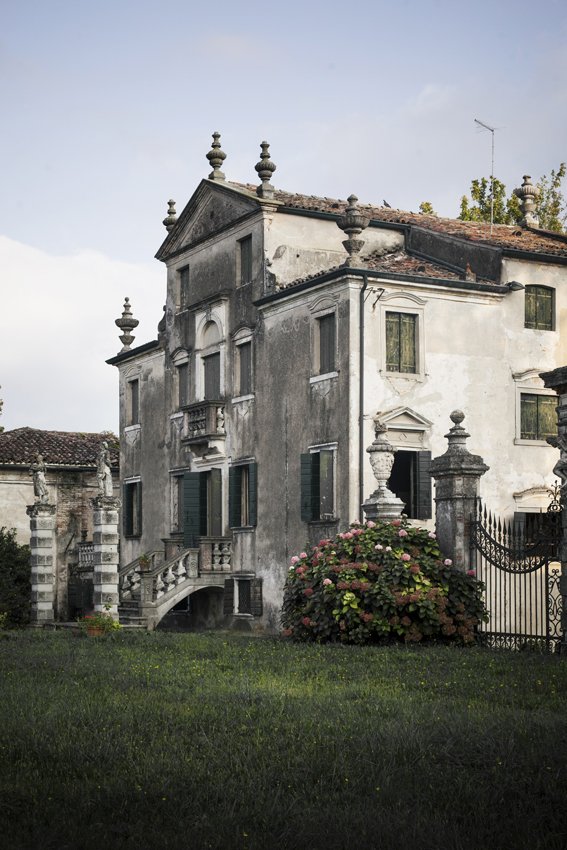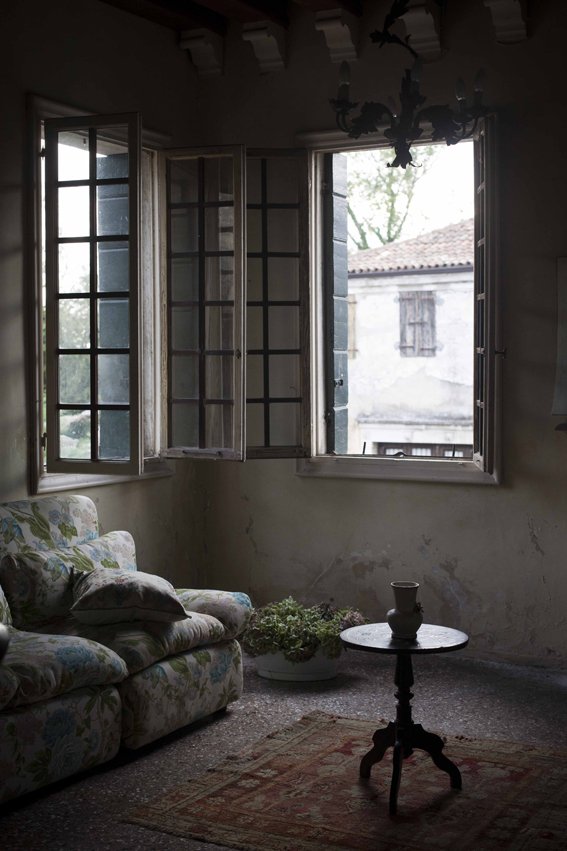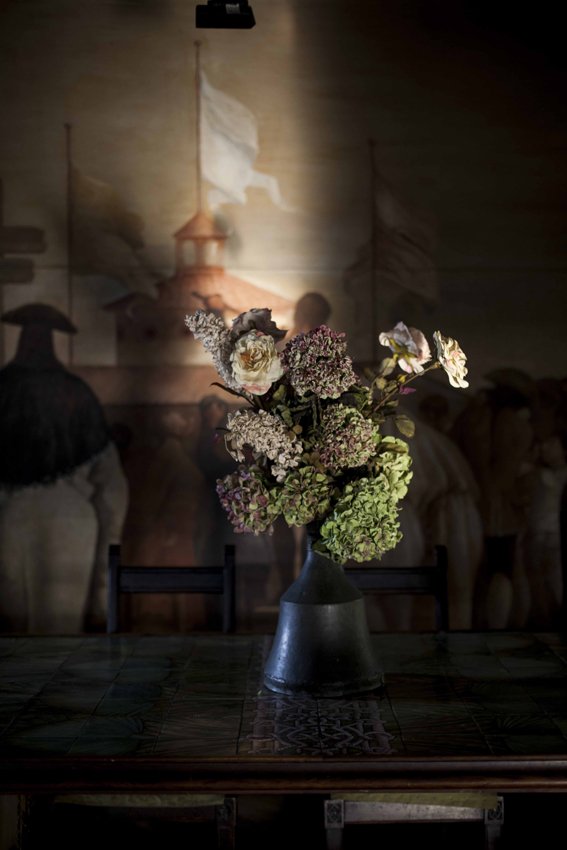Emilia amongst the secrets of the Painters’ Venetian Villa
[The villa in the pictures is Villa Tito, Dolo (Venezia).
A villa dating back to the 1700s, it is nicknamed the "Painter's House," a name given to it due to the fact that during the last century, it became the country home of the famous painter Ettore Tito, father of Luigi Tito, also a well-known Venetian painter and master of my father Luciano Zarotti].
(From my Mom’s diaries, winter 1990)
Early morning, almost dawn. I put on my rubber boots and, after a few steps, I turn right. It seems to be raining but it is only very wet. I cross the bridge over the canal which is lined by dark, too-severe magnolias. The great gate is always open: it is a passage for the peasants working in the neighboring fields. There used to be a forest here – they told me – where famous people like Hemingway went hunting. Passing through that gate is like receiving a special permit to enter another time, for me. A double line of century-old poplars draws a long avenue and allows us only a glimpse of the central part of a big 18th-century villa. There are wide untilled spaces that are kept as a garden. The tall trees make boundaries disappear. I love to wear my rubber boots, keeping my feet dry while I step on the wet grass. I am alone in this huge and silent space. I have threaded this path so many times that I could walk on it blindfold. At the end of the avenue, I usually turn left and, soon afterward, I turn right. Then the path becomes a secret, hidden, and private passage. The trees are taller and thicker, letting only a little light pierce through. I find a small wall and a little gate, which is set ajar and seems to have only a decorative function.
I find myself wondering how many people have crossed this little gate secretly or just for fun, perhaps as a challenge, on a dark or moonlit night, for love… who knows? This is the place where this kind of fantasies arise spontaneously. When I cross it, I take a narrow alley where only one person at a time can walk; it is a strip of earth between a tall boundary wall and a rainwater rivulet that never dries up. I find myself in a tunnel of bushes and leaves and interlaced branches, around me and everywhere I look. I smell the undergrowth and the light is even fainter.
I know that this is a precise borderline between two different properties, two important buildings with their wide gardens and annexes, an 18th-century and a 19th-century villas where two great and renowned families lived, one of musicians and the other one of painters. Their stories intermingled because of an arranged wedding which was meant to keep their huge properties within their families, and not for reasons of mere closeness.
Here I am – finally – back into the light. I get out exactly in front of the door – a secondary door, the one the servants used, leading directly to the kitchen on the ground floor. The main entrance of the big villa is at the left, where a grand staircase leads to the first floor, to a terrace leaning on the garden. When I arrive, I try to be silent to avoid scaring her – but the dog smells me and warns her. I find that little Granny shape on the door, smiling. Emilia. Now she is almost always alone in that big villa; nobody lives there anymore. When she arrived, she was perhaps fifteen years old. That was the way it worked in the countryside: young girls used to work as servants in the home of rich families. They lived there all the time, day and night, including holy days.
When I look at her now, her hair always clean and gathered, her apron and her gentle manners, I can tell how pretty she was when she was young – maybe that’s why the painter chose her. Now she has a meek look, a seemingly submissive attitude which nevertheless is no longer imposed on her; it is a sort of obedience deriving from good manners. In that big villa she not only took care of the home but also cleaned her master’s brushes – and his son’s brushes, when he also started painting. She saw the great Paintings, the true ones, which were commissioned to him: the great portraits of noble women and rich bankers. She listened to the beautiful piano in the hall upstairs, which was played by true Masters of music, even foreign directors. She saw at least sixty years of pomp with these great families of painters, lyric singers, sculptors, writers, musicians, famous guests. She served them all gracefully. Sometimes she still washes her mistress’s stockings when she passes by from town. She hangs them all on a line in the garden, near the tall pines where the chicks freely go sleeping at night.
When I go back into the kitchen, I find the typical smell of old countryside Venetian houses: a bit of humidity and a bit of coffee. Faint light and dried up hydrangeas in the vases. Behind the wood oven, the wall is covered by dark green art nouveau tiles. The copper pots hang bright; she cleans them with vinegar and coarse salt. I glimpse the big marble pool where water is drawn for kitchen chores in the back of the room, in the small dinette. Emilia’s smile feels good. She never moved from this house in her long and simple life, neither for love nor to go to church, because the family’s chapel is inside the villa’s garden. I believe that, when she was young, she most certainly had the grace which fascinates an artist. I recognized her in an etching: her gathered hair and apron like today, sewing in a moment of her youth. The author is the son, the Paronsin (‘little master’ in Venetian dialect) whose talent, perseverance and humility were always obscured by his father’s greatness. He wanted to become a monk when he was young, but then life pushed him in a completely different direction. Emilia breathed the colors and scents of painting, she always saw canvases everywhere, in the villa, in the studio, on the easels. She always shows and speaks of everything with great respect – something which her sister, when she passes by, often reproaches her.
I asked her if I could photograph her and she consented, maybe because she is accustomed to obedience. She sat on the marble bench, her dog beside her, looking far away, beyond the garden. When I took a second snapshot, a closer one, she told me that it was enough. She is not used to receiving attention and I felt that she did not want to be watched posing. When I decide to leave, she accompanies me for that brief path leading from her kitchen’s door to the small alley ending at the secret gate. Accompanying me to the exit is her graceful way to say bye. She has always accompanied everyone to the door, it was her duty. She walks with me until we reach the small gate which is the boundary of her life, the boundary between the outside and the inside. In the middle of all those leaves, the smell of the undergrowth, the humid autumn, she dares more than a simple greeting. At the very last minute, when I am already far away, she adds: I will always remember you!
I have never seen her again.









